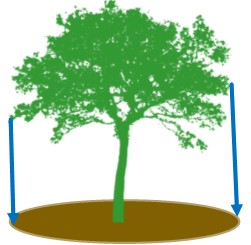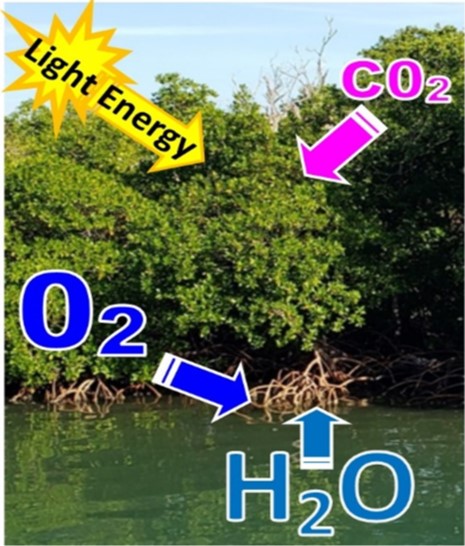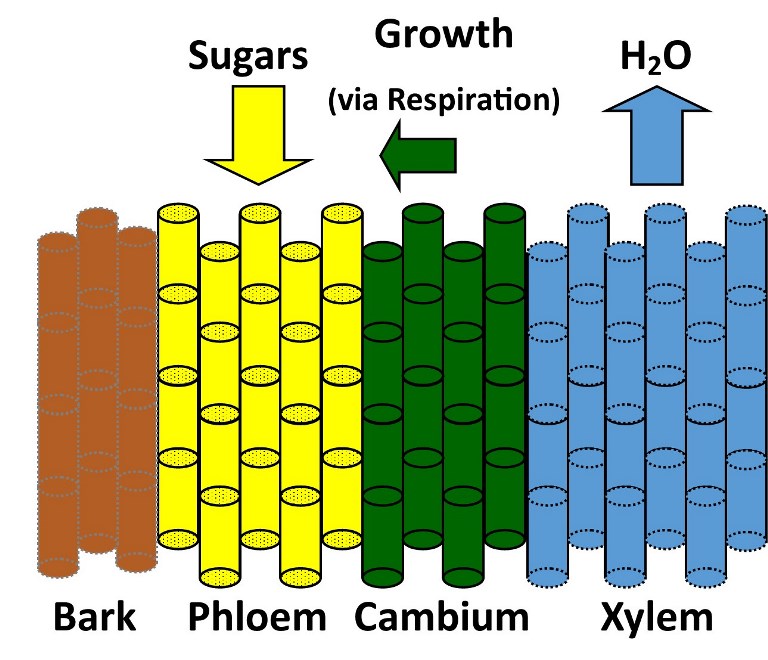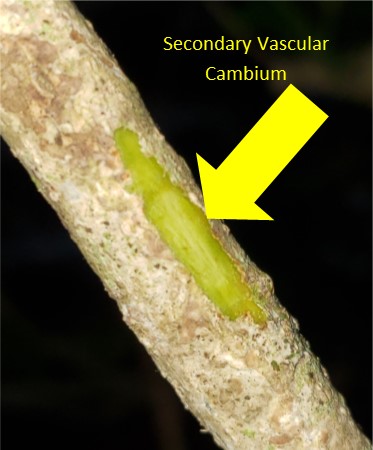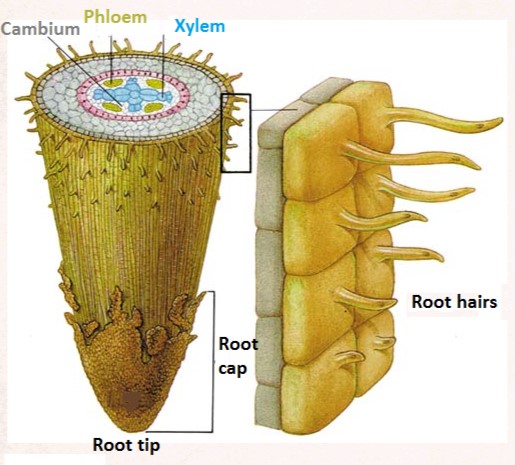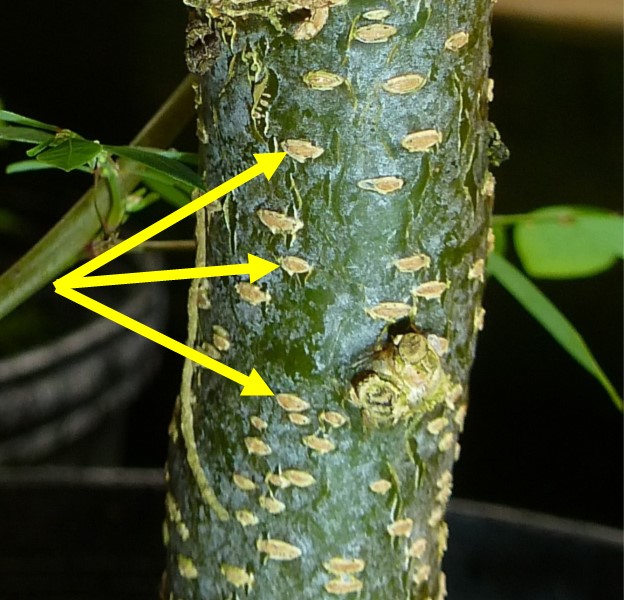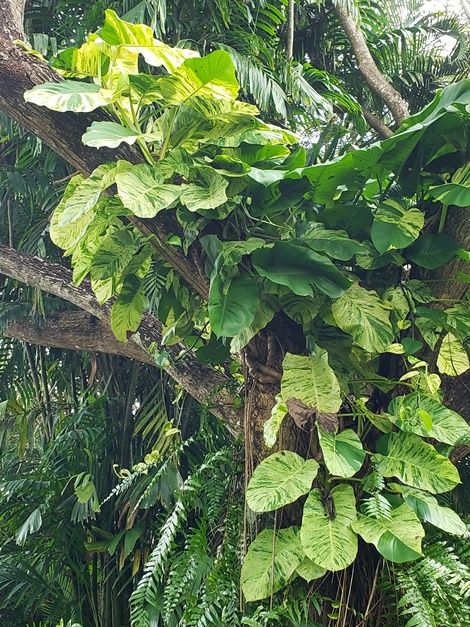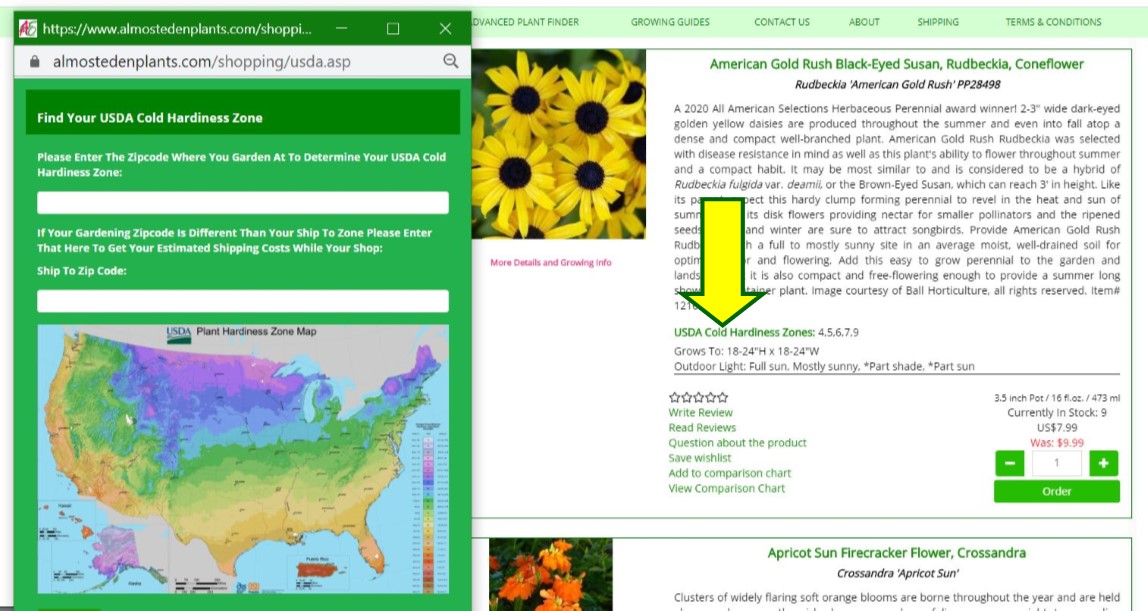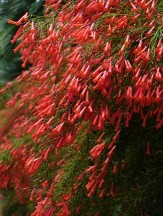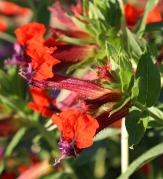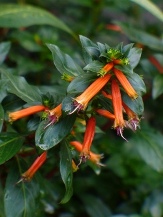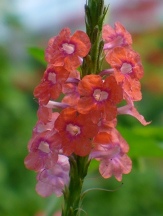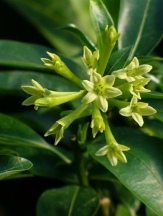Almost Eden's 2020 Fall Newsletter
DON’T MISS OUT ON OUR 2020 FALL SALE – IT ENDS ON NOVEMBER 30TH!
We are working to make way for the 2021 growing season and are offering over 70 great plants at excellent prices. This includes some of our most popular pollinator plants, some old favorites, and even a selection of some of our newest 2020 additions!
In This Issue:
Growing on the Edge: Getting Young Hardy Plants and Tropical Plants Through Winter
Proper Mulching Techniques AND a Deep Dive into Why Roots Need Respiration
Lenticels: Learn How Stems and Roots Breathe
New Website Features: Getting to Know Your Zone
GROWING ON THE EDGE: GETTING YOUNG HARDY PLANTS AND TROPICAL PLANTS THROUGH WINTER
As gardeners, speaking for myself at least, we always want to try new, exotic, and/or unusual plants and often that entails gardening on the edge of a plant’s USDA Cold Hardiness Zone rating. We happily garden in zone 8B, the warmer half of zone 8, and so we see winter temperatures here that on average fall to about 15oF. Unlike parts of zone 7 and colder winter regions, our soil does not typically freeze to any real depth. This is probably one of the most limiting factors for tropical species, making these showy plants one more possibility for our gardening palette. The more that you know about the species or cultivars that you are working with, the easier it will be to successfully get them through to spring.
Del Rio, TX
Plant cold hardiness ratings are typically set for well-established garden and landscape plants. Many of the hardiest and most reliable tropical plants can easily be overwintered successfully as living crowns beneath a layer of mulch even though the top portion of the plant may freeze. When writing about these types of tropical plants, I often refer to them as “die-back perennials” because the tops literally freeze and then die-back to the crown each winter, but they are still able to become a beautiful and productive part of the garden the following season. Examples are Angel’s Trumpets or Brugmansias (some but not all Daturas), Turks Caps, Confederate Roses, Lantana, and most common types of Hedychiums – like the White Butterfly Ginger. Lantana, for example, is actually a tropical shrub that freezes back to near ground level in our zone 8 gardens and then typically returns from the crown in spring once soil and air temperatures have warmed sufficiently enough for it to initiate growth. Some of the hardier Lantana cultivars, like Miss Huff and the Chapel Hill© series, have proven to be reliable even into zone 7. Crape Myrtles and Vitex develop into large shrubs or small trees here in zone 8 but in zone 6 these same plants are grown as die-back perennials, like our Lantanas here in 8B. Plants like these that are to be grown on the edge of their hardiness ranges should be planted out as early in the growing season as possible to ensure that they have a strong crown and well-established root system with enough resources and vigor with which to be able to successfully resprout the following spring. A secondary option is to overwinter young plants in containers to give them that much more time to develop a strong healthy crown and supporting root system before adding them to the garden and landscape the following spring.
Some well-established tropical and subtropical plants may be able to successfully overwinter and regrow but may not perform as well as we might hope the following growing season as garden or landscape plants. One common example of this is the Tropical or Chinese Hibiscus, Hibiscus rosa-sinensis, including many of its cultivars and hybrids. Some of the more vigorous types of Tropical Hibiscus, like El Capitolio shown at left, may survive a zone 8 or 9 winter but may not grow vigorously enough to flower much, if at all, before fall and winter arrive again the following year. If you only have occasional winters that produce freezing temperatures, then this may be acceptable as most years these plants will likely live up to their potential and then when a hard winter does come these plants should hopefully still survive it. Otherwise, it may be necessary to grow these cold sensitive tropical plants in containers and provide them with a warm sunny window or other freeze and frost-free area for winter.
October 10, 2010, Kennett Square, PA
USDA Cold Hardiness Zone 7A
Not all tropical species can be successfully overwintered in the ground here in our zone 8B gardens and so must be maintained as container plants. Containerized plants, including many plants that may be considered reliably cold hardy in your zone, may need to be protected from extended periods of freezing temperatures. Even though temperatures may remain above the plant's known cold hardiness rating, soils in containers are more susceptible to freezing, thus potentially freezing and killing the tender root system and crown buds of what may be an otherwise reliably hardy garden or landscape plant. It may seem obvious, but it is important to remember that small containers can freeze solid much more quickly than large containers and so even a few hours of below freezing temperatures can be devastating for some of the more sensitive tropical species. Containers that are in good contact with the ground are generally more resistant to freezing than those that are on raised decks, porches, patios, and tables. In the case of containerized young cold hardy species, if that species or cultivar can handle zone 3 or 4 winters then you can be fairly confident that it can handle extended bitterly cold periods as they have proven to be able to survive in these areas where the soil can freeze to significant depths. As container plants, these very hardy plants can probably handle about anything that an average zone 8 winter can throw at them. If a plant’s cold hardiness range is limited to zones 7 or 8 to 10, it may be because the root system of that plant is unable to tolerate frozen soils. Cold hardiness ratings often vary from resource to resource for a given plant so be sure to read the fine print. In many cases, information may be gleaned from other gardeners or horticulturists who have experience with that plant under similar growing conditions as your own.
Cold in combination with wet soils can be the death of tropical and young newly established plants and so good to excellent drainage can be critically important. Raised beds and sandy well-drained soils can go a long way toward providing optimal conditions for winter survival when it comes to cold sensitive species. This also provides a gardener or landscaper with a broader range of plants to utilize as many more plants are tolerant of well-drained soils than those that can handle heavy, wet winter sites. We’ll discuss why good soil drainage is so important for many plant types in extensive detail below. Another thing to keep in mind is that these plants, especially the more tropical types, may not even consider initiating spring growth until soil and air temperatures are appropriately warm and the days have begun to lengthen so don’t give up on them too early. For some tropicals and even the cold adapted Hardy or Perennial Hibiscus it can be late April, May or even early to mid-June before they start to show themselves.
For most of the more reliable die-back perennials and for young newly established cold hardy species a mulch is often necessary to insulate and protect the tender buds of the crown from freezing temperatures and exposure to repeated frosts. The dead winter stems of die-back perennials may also provide some additional protection for dormant buds and so, in our own gardens, we typically wait until spring growth initiates before cutting away the dead upper portions. This can also give you a leg up after a mild winter as the plant may not have frozen back as far as normal, providing more living growing points from which they can produce more vigorous early season growth. A protected site can offer additional protection, like on the leeward or downwind side of a structure, that may help to protect them from the coldest harshest drying winter winds. An overhanging eave or evergreen tree or shrub can provide additional protection from repeated or late season frosts.
It may seem counterintuitive but plants in moist soils are actually more resistant to cold weather extremes than those that are in dry soils. The moisture acts as something of an insulator and fully turgid (or plump and water filled) plant cells are generally more resistant to freezing temperatures than those that are drought stressed. For both containerized plants that will remain outdoors and in-ground garden and landscape plants, be sure to water thoroughly a day or two prior to an upcoming freeze to ensure that the plant's root system will have time to draw in needed moisture as uptake can be slower when temperatures are colder. Another reason to keep your plants moist, never soggy wet, is that cold drying winds can pull moisture from exposed plant parts creating drought stressed conditions even in an otherwise icy landscape.
Viburnum dentatum
USDA Cold Hardiness Zones 2-9
Fall, winter, and early spring are without a doubt some of the easiest times to establish reliably hardy perennials and woody species in zone 8. This has a lot to do with the fact that the demand for moisture tends to be lowest at these times of year due to slower top growth as well as the fact that their root systems, in these areas where soils generally do not freeze, can continue to grow all winter making them better able to withstand the coming stresses of spring and summer. For tropical and temperate species that are grown as die-back perennials in your area, establish them as early in the season as possible to ensure the development of a large established root system and crown, from which they will be able to vigorously return in spring. Wait to plant these until all danger of freeze and frost have passed and once soil temperatures have begun to warm significantly. In our area, that usually means waiting until about mid-April or early May and the most reliable of these hardy tropicals can be successfully established until about midsummer. With proper preparation and a deeper understanding of a specific plant’s needs, we can get many tropical species through winters beyond their cold hardiness zone. Enjoy the adventures of gardening on the edge!
THE MANY MERITS OF MULCHING AND A DEEP DIVE INTO WHY ROOTS REQUIRE RESPIRATION
optimally extend to the
outer edges of the plant's
foliage or beyond.
A properly applied, breathable yet insulative, organic mulch, like pine straw, can help to gain a gardener as much or more than half of a cold hardiness zone. A proper mulch will help to trap stored heat from the soil and hold it around the crown of the plant as well as serving to shield tender buds beneath it from repeated frosts and freezes. A mulch helps to moderate soil, root, and crown temperatures from extremes not only in winter but also throughout the growing season. A late winter or early spring warm spell can heat the exposed soil's surface prematurely possibly triggering early spring growth that can literally be nipped in the bud. With a mulch in place the soil temperature is kept slightly lower and initial spring growth is delayed until temperatures have stabilized and are more conducive to growth. A mulch can be critically important for young starter plants and cold tender species that need this extra blanket of protection during their first year or more of establishment.
By ‘properly applied’ it’s implied that it must be at an appropriate depth for the type of mulch being used as well as taking into consideration the size of the plant or plants that it is to be used around. For pine straw, once it has settled, and most mulches, LSU AgCenter recommends that it should be about 2-4 inches deep to be effective. Use the shallower end for smaller transplants and lower growing plants as well as for plants that may be sensitive to higher soil moisture levels (Lavender and Agastache come to mind). The mulch can be slightly deeper for larger trees and shrubs but still is generally not recommended to be over about 4 inches deep. Mulch volcanoes are a common gardening and landscaping mistake. This is where there is a mound of mulch that is much deeper at the base of the plant and then it quickly slopes outward to nothing. Mulch should be evenly applied across the entire root zone. Optimally, it should extend from the base of the plant out to the edge of the plant's dripline. The dripline is an imaginary circle with a radius that extends to the outermost edges of the plant's branches. The fine young feeder roots typically extend to the outermost edges of this circle and this is where the most competition for resources such as water and nutrients occurs. Apply mulch to the proper depth across the entire root zone for maximum effectiveness against weeds, for optimum moisture retention and temperature moderation, and for creating healthier soil conditions to help your plants grow to their full potential.
Harvest Caye, Belize
Mulches around desirable plants should be ‘breathable’. Oxygen absorption by roots is critical for cellular respiration and thus plant growth. This is why the Bald Cypress and Mangroves produce aerial roots above the natural water line. These aerial roots, or pneumatophores, allow for this air exchange to occur even when these plants are growing in what are anaerobic or oxygen deprived conditions. These plants are the exceptions and the great majority of terrestrial plants do not have the ability to survive in anaerobic conditions. In my humble opinion, this is one of the most important lessons that a gardener can learn and apply to be successful in growing plants: “Leaves need light AND roots require respiration!”. A proper mulch is breathable in that it will still allow for this natural air exchange to occur with surface roots as well as allowing moisture and fresh air to penetrate into the root zone. As moisture passes downward into and through the soil, fresh air is drawn in behind it and exhaust gases are pushed out helping to maintain these healthy aerobic or oxygen rich conditions. As a result, properly applied, breathable, organically mulched plants are healthier, more vigorous, and are more resistant to attack by pests and disease.
What do you mean by plant roots need oxygen?!? We all learned in school that plant leaves use carbon dioxide, water, and light energy in photosynthesis (light energy + 6CO2 + 6H2O → C6H12O6+ 6O2) to create sugars with life giving oxygen as a byproduct. Ah, but this is only half of the equation young grasshopper. In order to release and utilize the sun’s energy that is stored as sugars for cellular processes, like cell division and thus plant growth, the cell’s mitochondria use respiration (C6H12O6 + 6O2 → 6CO2 + 6H2O + energy). As you can see in the chemical equation, respiration requires exposing these sugars to oxygen and this reaction then releases the stored chemical bond energy along with carbon dioxide and water as byproducts. Without oxygen for respiration root hairs die; water, oxygen and nutrient uptake is no longer able take place; cell division and photosynthesis are unable to continue due to a lack of water; exhaust gases build up and eventually cell death occurs. This is the same reasoning behind aerating your lawn if you have soil compaction, it provides a means to get more oxygen to the root system and thus improve plant health and vigor. Remember: “Roots Require Respiration!”
The root system of a plant uses the stored sugars which flow downward in a plant from the leaves via the phloem in the stems for plant growth on a cellular level (see diagram at left). The phloem is composed of tiny bamboo-like tubular cells stacked atop one another that are just below the bark in woody plants with gate-like sieve plates at each end of the cells to control flow. If you scratch the bark of a woody plant stem and you see green beneath it, like in the image at right, this is the secondary vascular cambium that is responsible for lateral growth or stem and root thickening. The cambium is green because it too contains chlorophyll and it too captures UV light and produces sugars even beneath the bark of a woody plant. This is where much of the photosynthesis occurs in deciduous plants during winter and we can see by the thinner darker tree rings that growth is still occurring during this ‘dormant’ period (see Photosynthesis in Aspen Bark by L. C. Pearson and D.B. Lawrence – American Journal of Botany in references below to learn more).
Scratching a plant stem is one way that we can check to see if a deciduous plant, or that stem at least, is alive. If there is no green layer, then there is no growth and so that part of the plant may be dead. Water and dissolved nutrients travel upward from the roots via the xylem bathing one side of the few cells thick layer of the vascular cambium in moisture and dissolved nutrients, while it is bathed in sugars on the other via the phloem. The xylem is basically composed of dead phloem cells that have lost their gates creating tubular pathways for water to flow upwards with minimal resistance like a straw. Respiration and thus the presence and availability of not only moisture and sugars but also the presence of oxygen is critically important for plants to be able to continue to grow and thrive. As one of my most memorable and esteemed professors, the late Dr. Carlos Smith, explained during our Master Gardener classes “Once a plant stops growing (or respiring) it dies, period.” Plants can live for a short time without light (they do it for about half of each day already) but will not survive long without necessary moisture, sugars, oxygen and the resulting cellular respiration. Even ‘dormant’ plants and bulbs are all still growing, and the process of respiration is still occurring but just at a very slow rate. This is why horticulturalists continually refer to the fact that “roots need oxygen” and thus a proper mulch must be breathable to be beneficial.
borrowed from: Plant Transport Biology Notes on SmartEduHub.com
Let’s dig a little deeper into the root of the problem, pun intended. The reduction or complete elimination of air exchange that occurs within the root system of a plant, both in surface roots and the fine hair-like aerobic feeder roots, is the most basic cause behind some of the most common mistakes that new gardeners make. Planting plants too deeply, over-watering, over-uppotting small plants into too large of a container and keeping water in a plant's saucer continuously can all lead to the death of these oxygen requiring surface roots and feeder roots. We often aptly call this condition ‘root rot’ because this is literally what happens when these roots are suffocated and, like most any other living organism that is starved of air, they die. To replace the dead and dying root hairs, the root tips must grow but it may be unable to do so because of a lack of oxygen for cellular respiration. Too wet from over-watering, using saucers as basins instead of as catch pans, and planting too small of a plant into too large of a container can all lead to soil that remains super-saturated for too long of a period and is oxygen deprived. The excess moisture fills the natural air pockets in the soil pushing the oxygen out of the root zone. This can also potentially even lead to the collapse of these natural air pockets creating additional soil compaction issues. These anaerobic or oxygen deprived conditions literally cause the suffocation and death of the hair-like feeder roots that perform so much of the air exchange and moisture absorption that occurs in this part of the plant. At that point, no matter how much you water, the plant will often remain wilted because it has lost these fine roots that do the heavy lifting when it comes to moisture and nutrient uptake from the soil.
Lenticels: How Plant Stems and Roots Breathe
Lenticels are specialized tissues in a plant’s bark, that may occur in both stems and roots, that allow for air exchange to occur. As you can see in the image above the bark appears to be green and we know that this is because it contains chlorophyll within the vascular cambium. The oval tan spots on the plant stem indicated by the yellow arrows in the image above are the lenticels. They are also one of the most noticeable characteristics of species of Prunus, like the horizontal ridges on the Black Cherry bark below.
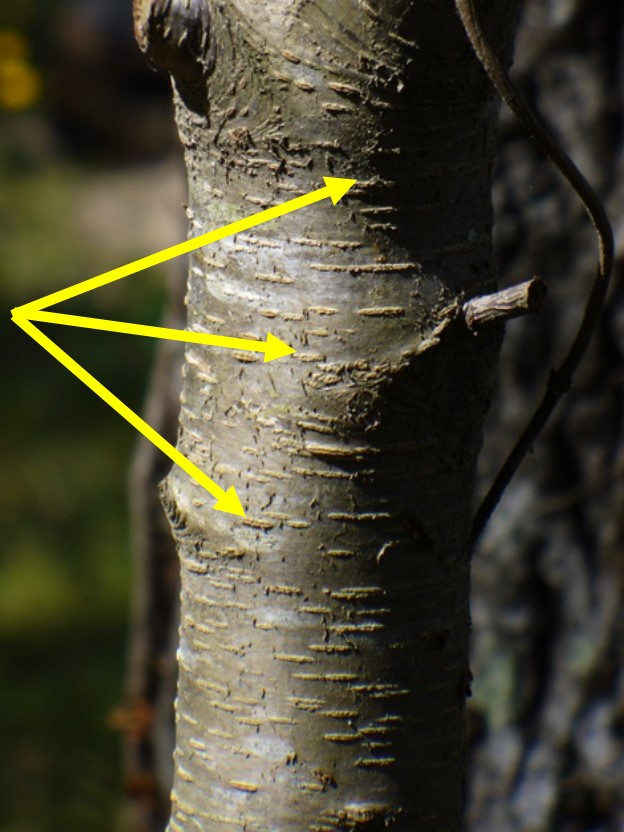
Let’s step back and look at the photosynthesis equation again, noting particularly the oxygen that it gives off: 6CO2 + 6H2O + light energy → C6H12O6 + 6O2. As photosynthetic plant cells create sugar molecules, they are also giving off oxygen. The excess oxygen, not utilized by that cell’s mitochondria or other processes, diffuses through the cell walls into air spaces between the plant’s cells and may diffuse out into the atmosphere via the stomata and lenticels (learn more about Lenticels in the sidebar at right) or may be transported to other parts of the plant. The further removed from the oxygen producing photosynthetic cells, lenticels, and stomata you move, the lower the oxygen concentration becomes as it is used up by non-oxygen producing plant cells. So in the most basic sense, the further from the foliage and lenticels you move, the more the oxygen is depleted and the more it is needed. What plant part is furthest from the leaf? The root tip. Once the moisture absorbing root hair cells die those roots are no longer able to pull moisture and oxygen from the soil. Now think about what plant part is farthest from the water absorbing root hairs at the root tip: the leaf, and more specifically the leaf tips and edges, as well as the primary cambium that is responsible for stem elongation or growth. The further you get from the root tip the more important moisture becomes and so we start to see signs of cell death at the leaf edges due to drought like conditions. These plant parts no longer have enough available moisture to continue respiration and photosynthesis and thus cell death occurs. Browning at the leaf edges, leaf tips, and the growing points where stem elongation is occurring is the first sign of plants that are staying too wet even though at first that seems counterintuitive. We must remember that roots need oxygen, even in water loving species, and without oxygen plants become ‘moisture stressed’, diseases are able to invade and attack, the root system is destroyed and ultimately, we lose precious plants. Remember, as my father (John) has always tried to stress “Take care of the roots because the roots take care of the top!”. Roots require oxygen for respiration, and it is just as important as photosynthesis in the foliage and stems, if not more so.
Yes, there are plants that have the ability to grow in water. One of the most common and memorable instances that offer proof of this concept is the beautiful glossy bright yellow and green heart-shaped foliage of a Pothos Ivy wrapping around an entire office space or basking in the light of a kitchen window with only a vase or jar of water to grow in. So how do you explain to this proud plant parent why the Closet Plant or Spathiphyllum in the corner is turning dark brown to black due to too much water? A Closet Plant, a.k.a. Spathiphyllum, or other indoor plant, is normally planted in potting soil and as the organic matter and dead roots begin to rot this creates extremely toxic conditions for the root system further degrading growing conditions. In fact, a Closet Plant can be grown in just water (hydroponically), without soil, if it is oxygenated, like in a fish tank. So, yes, some plants can survive indefinitely under healthy anaerobic conditions. Anaerobic cellular respiration is not only a more complex process, but it is less efficient at utilizing the chemical bond energy available in the sugars. Cell growth in the root system is then slowed down and thus overall plant growth is slower. Most terrestrial plants are not able to survive for long under anaerobic conditions and even those that can still need healthy root zone conditions for suitable growth and vigor.
Newspaper, cardboard, sheets of plastic, and fresh green grass clippings (that are hopefully free of weed seeds) are all examples of mulches that can mat together and/or create a barrier preventing natural air exchange and thus the loss of respiration in the root zone. These types of mulches can be used to good effect to smother undesirable weeds and grasses in future garden areas without the use of herbicides. My father-in-law, the noted botanist, author, and retired professor Dr. Charles Allen, uses this method on a regular basis to good effect. These types of non-breathable mulches are generally not suitable for use around desirable plants because they can create an impenetrable layer preventing this all-important air exchange and even eliminating many of the desirable microbes and mycorrhizal fungi. Now we are back to anaerobic conditions with roots starved of oxygen. Of course, over time the biodegradable mulches in this group will break down and the microbes and mycorrhizal fungi will eventually re-colonize the area once the anaerobic conditions have dissipated. The area can then be utilized to successfully establish new plantings.
Properly applied, breathable, organic mulches have many more advantages than just aesthetic value (beautification), moisture retention, the promotion and improvement of respiration in the root zone, weed control and prevention, and temperature moderation. The organic mulch that is in contact with the soil is broken down further and further via the natural decay processes of soil microbes and symbiotic mycorrhizal fungi. Did you know that over 90% of plants are known to develop symbiotic relationships with mycorrhizal fungi! Some plants simply are unable to survive without mycorrhizae, like the magnificent Longleaf Pine and Blueberries, and most other plant species benefit greatly from this symbiotic relationship. As the microbes work, including the beneficial fungi, they break the organic matter down into its most basic components and some of this is released back into the soil or is shared with the roots via the beneficial fungi in a form that plants can utilize. The actions of the microbes and mycorrhizae make the soil more porous and these air pockets and passages created by the actions of these microbes in the soil are filled by oxygen rich air and moisture. The soil becomes friable, or loose and crumbly, and less compacted making it easier for roots to penetrate the soil where they can acquire new nutrients as well as making it so the plant can grow larger, stronger and more vigorously. The plants are healthier and less stressed and so it is easier for them to fight off and resist attack by pests and diseases. Plants can flower and fruit more readily, produce and ripen larger crops, and often even at a younger age. Organic mulches also create an environment that promotes populations of beneficial nematode predators. Mulches that do not float away even help prevent and reduce erosion. There are so many advantages to a properly applied, breathable, organic mulch that it should become a requisite part of every gardener’s planting process and landscape regimen.
You can check to see what the horticulturists in your region recommend for mulches by using the search function at extension.org or find your local county extension offices via the USDA's NIFA Land-Grant University Website Directory.
GET TO KNOW YOUR ZONE ON ALMOSTEDENPLANTS.COM!
We are super excited to announce a couple of long-awaited new features on our website! Now you can quickly and easily find your USDA Cold Hardiness Zone from our website without having to go through the Captcha code entering process on the USDA’s website AND it will give you an estimated shipping cost using our new zip code and weight based shipping calculation for the products in your shopping cart. For registered customers, who are logged into the website, your estimated shipping cost will be automatically displayed and either one can be readily changed if your information changes. If your gardening zip code is different than your shipping zip code, you can enter both zip codes to ensure that you still get the correct shipping estimate.
References
Hidden Partners: Mycorrhizal Fungi and Plants by NYBG Herbarium Intern Matthew Pace on the New York Botanical Garden website at: https://sciweb.nybg.org/science2/hcol/mycorrhizae.asp.html
Mulch Aids Plant, Soil Health by Dr. Allen Owings, (now retired) LSU AgCenter Horticulturist on the LSU AgCenter website at: https://www.lsuagcenter.com/portals/communications/news/news_archive/2015/september/headline_news/mulch-aids-plant-soil-health
Reviewing The Use of Landscape Mulch by Richard Bogren, John Young, Dan Gill, and Allen Owings – LSU AgCenter News You Can Use:
Photosynthesis in Aspen Bark by L. C. Pearson and D. B. Lawrence in the American Journal of Botany - Vol. 45, No. 5 (May, 1958), pp. 383-387: https://www.cedarcreek.umn.edu/biblio/fulltext/Amer%20Jou%20Botany%20Vol%2045%201958%20Pearson.pdf
Thank you for taking the time to peruse our 2020 Fall Newsletter and if you know of anyone who would be interested in reading it you can forward it to them by copying the below link:
Almost Eden’s 2020 Fall Newsletter
Textual version of the link: https://almostedenplants.com/shopping/growing_guides/Almost Eden's 2020 Fall Newsletter.pdf
You can sign up to receive our periodic newsletter here.
Thank You & Good Growing,
John, Bonnie, & Jeff McMillian
& the Crew at Almost Eden
1240 Smith Rd
Merryville, LA 70653
337-375-2114

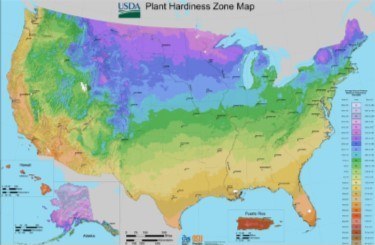
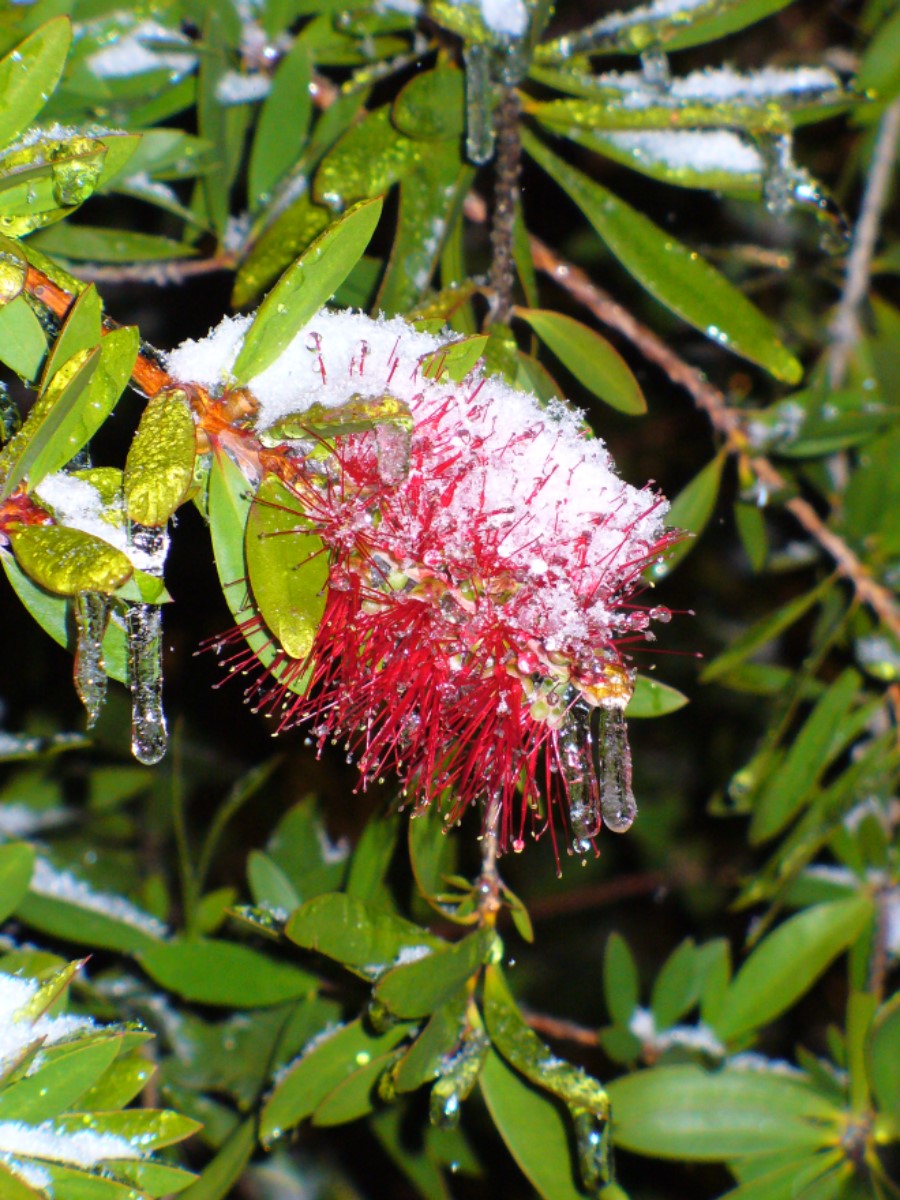

.jpg)

